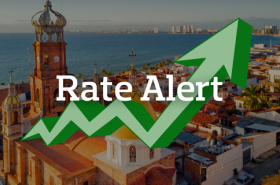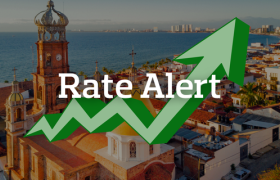Quick Contact

1st February 2019
Overnight the AUD continued to strengthen against major currencies around the world, so much so that exchanging today will give you substantially more than if you exchanged last Friday, 25th Jan.
As it stands, one Aussie Dollar will buy you:
0.7065 US dollars
0.6087 euros
0.5327 Great British pound
0.8971 Canadian dollars
1.0154 New Zealand dollars
Exchanging $2000 AUD today compared to last Friday will have you taking off with a bonus:
34.40 USD
2584.60 JPY
15 EUR
21.80 GBP
14.60 CAD
This improvement is the perfect example of how important it is to do some research into foreign currency prior to leaving for your holiday. Give yourself the extra peace of mind by adding Rate Guard to your currency purchase in store as well. It’s free, and if the rate improves within 14 days of purchase we will refund you the difference*. Who knows, it could mean an extra $34.40 worth of burgers on your Route 66 road trip!
So, what led to this upward pressure on the value of the Aussie dollar? Let’s take a look at the week that was in foreign exchange markets around the world.
USA
The key event in the States this week was the January meeting of the Federal Open Market Committee (FOMC). They refrained from increasing US interest rates, citing caution as a result of global risks such as decelerating growth in China and the wider global economy, as well as the flow on effects Brexit may have on the US.
The US Government reopened last Friday the 25th of Jan, however, this was only done on the premise of remaining open for three weeks. With two weeks left, there is no long term solution in sight, so we are not in the clear of another shutdown (or more tweets from Trump) yet.
The lack of interest rate increase was good news for the Aussie Dollar, as it allowed the AUD to remain competitive against the USD in the eyes of investors. It will be interesting to see how future decisions around the government shutdown will affect the value of the USD against our Aussie Dollar.
EUROPE
The Eurozone certainly hasn’t had the best week. December data came out showing that Germany had the largest decline in retail sales in 11 years.
The third largest economy in Europe, Italy, has also fallen into a recession, and gross domestic product (GDP) for Europe rose at its slowest pace in five years during Q4. Ouch.
Not great for Europe, especially as they (and the rest of the world) continue to brace for Brexit in March.
Speaking of Brexit, British MP’s voted on Tuesday on a number of amendments to the current Brexit withdrawal agreement. There was a resounding push for changes to the Northern Ireland backstop. As a result, Prime Minister Theresa May will spend the next few weeks negotiating with MP’s and the European Union on a new deal.
This is troublesome considering 1. The EU has already stated they will not renegotiate the current deal, and 2. Brexit is now less than two months away.
CHINA
The US and China are continuing their high-level trade talks today in Washington, however, there is little indication as to whether any progress (positive or negative) has been made.
President Trump tweeted that "no final deal will be made" until he and Chinese President Xi meet in the future to discuss the more difficult points.
A concluding statement for the current round of talks will be released later today. This statement could very well have an impact on the value of the Aussie Dollar. Our strong trade ties and the resulting reliance on the performance of the Chinese economy means any type of negative sentiment resulting from the trade talks could flow through to the performance of the AUD.
AUSTRALIA
Perhaps one of the biggest influences on the strong Aussie Dollar this week was soaring iron ore prices. Iron ore is one of Australia’s biggest exports, and uncertainty over the outlook of Brazilian supply has increased the prices, thus giving us a greater return (and more demand) for our exports. Higher demand for exports = higher demand for the AUD.
This week also saw the release of Australia’s Q4 2018 Consumer Price Index (CPI) report. Despite the inflation increase rate beating expectations of 0.4% at 0.5%, the total annual inflation rate came in at 1.8%. This is under the 2-3% target set by the Reserve Bank of Australia (RBA).
So, why aren’t we meeting the RBA’s targets? Well, rent and household prices are seeing disinflation, hitting multi-decade lows. As they make up 15% of CPI, their decline is putting significant downward pressure on the total figure.
The inflation rate has large implications on interest rates which, in turn, influence the value of a currency. The Aussie inflation rate has been below the 2-3% target band for most of the last three years which has lead the RBA to keep interest rates at record lows for more than two years.
Only time will tell if global market pressures, such as the US/China trade war and slowing global economy will cause the RBA to increase interest rates in the future.
The RBA will have its first meeting for 2019 next Tuesday. Markets believe they will keep interest rates on hold, however, the corresponding statement may provide insight into their moves for the rest of 2019.
This blog is provided for information only and does not take into consideration your objectives, financial situation or needs. You should consider whether the information and suggestions contained in any blog entry are appropriate for you, having regard to your own objectives, financial situation and needs. While we take reasonable care in providing the blog, we give no warranties or representations that it is complete or accurate, or is appropriate for you. We are not liable for any loss caused, whether due to negligence or otherwise, arising from use of, or reliance on, the information and/or suggestions contained in this blog.
All rates are quoted from the Travel Money Oz website, and are valid as of 1 February 2019
*Terms and conditions apply to Rate Guard. See https://www.travelmoneyoz.com/rate-guard for more information.













